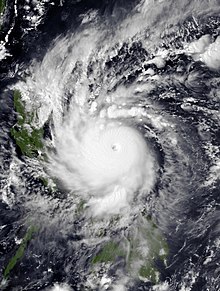 Goni at peak intensity, approaching the Philippines on October 31 | |
| Meteorological history | |
|---|---|
| Formed | October 26, 2020 |
| Dissipated | November 6, 2020 |
| Violent typhoon | |
| 10-minute sustained (JMA) | |
| Highest winds | 220 km/h (140 mph) |
| Lowest pressure | 905 hPa (mbar); 26.72 inHg |
| Category 5-equivalent super typhoon | |
| 1-minute sustained (SSHWS/JTWC) | |
| Highest winds | 315 km/h (195 mph) |
| Lowest pressure | 884 hPa (mbar); 26.10 inHg |
| Overall effects | |
| Fatalities | 32 |
| Damage | $1.02 billion (2020 USD) |
| Areas affected | Philippines, Vietnam, Cambodia, Laos |
| IBTrACS | |
Part of the 2020 Pacific typhoon season | |
Typhoon Goni, known in the Philippines as Super Typhoon Rolly, was an extremely powerful tropical cyclone that made landfall as a Category 5 equivalent super typhoon on Catanduanes in the Philippines, and in Vietnam as a tropical storm. It is the strongest landfalling tropical cyclone on record by 1-minute maximum sustained winds. The name "Goni" means swan in Korean. The nineteenth named storm, ninth typhoon, and second super typhoon of the 2020 Pacific typhoon season, Goni originated as a tropical depression south portion of Guam on October 26. It was then named as Tropical Storm Goni on October 27. On the next day, Goni explosively intensified over the Philippine Sea, becoming a Category 5–equivalent super typhoon on October 30. Goni maintained Category 5 strength for over a day, before making landfall on Catanduanes at peak intensity, with 10-minute sustained winds of 220 km/h (140 mph),[1] and 1-minute sustained winds of 315 km/h (195 mph), with a minimum central pressure of 905 hPa (mbar; 26.72 inHg). It was the most intense tropical cyclone observed worldwide in 2020.[2]
Following its first landfall, Goni rapidly weakened while it moved over the Sierra Madre mountain range of the Philippines. The storm brought severe flash flooding to Legazpi, as well as lahar flow from the nearby Mayon Volcano. There were widespread power outages as well as damaged power and transmission lines in Bicol. Crops were also heavily damaged. Over 390,000 out of 1 million evacuated individuals have been displaced in the region. Due to the extreme wind speed of the typhoon, two evacuation shelters had their roofing lost. Debris and lahars had also blocked various roads, as well as rendering the Basud Bridge impassible. In Vietnam, where Goni made landfall as a tropical depression, there was flooding in numerous areas, as well as eroded and damaged roads. This exacerbated the 2020 Central Vietnam floods, causing an estimated ₫543 billion (US$23.5 million). In all, the typhoon killed at least 32 people and caused at least ₱20 billion (US$359 million) worth of damage.[3] The COVID-19 pandemic was also a concern for people in evacuation centers.[4]
After Goni moved into the South China Sea, it weakened to a tropical storm. It started to move generally westward towards Vietnam. It eventually reached the country late on November 5 as a tropical depression, bringing heavy rain and gusty winds. International relief from several countries as well as the United Nations followed soon after the typhoon moved away from the Philippines.[5] The relief included donations totaling up to $11.48 million and protection from the pandemic, among other items.
- ^ "Typhoon 202019 (GONI) – Detailed Wind Information (Japan Meteorological Agency Best Track Data)". Digital Typhoon. National Institute of Informatics. Archived from the original on November 1, 2020.
- ^ Samenow, Jason. "Super Typhoon Goni explodes into 2020s strongest storm on Earth, moves toward Philippines". The Washington Post. Archived from the original on October 31, 2020. Retrieved October 31, 2020.
- ^ Cite error: The named reference
AONwas invoked but never defined (see the help page). - ^ Ratcliffe, Rebecca (November 2, 2020). "Typhoon Goni: thousands of homes in Philippines feared destroyed". The Guardian. ISSN 0261-3077. Archived from the original on November 2, 2020. Retrieved November 2, 2020.
- ^ "SitRep No.07 re Preparedness Measures for Super Typhoon Rolly" (PDF). NDRRMC. November 5, 2020.